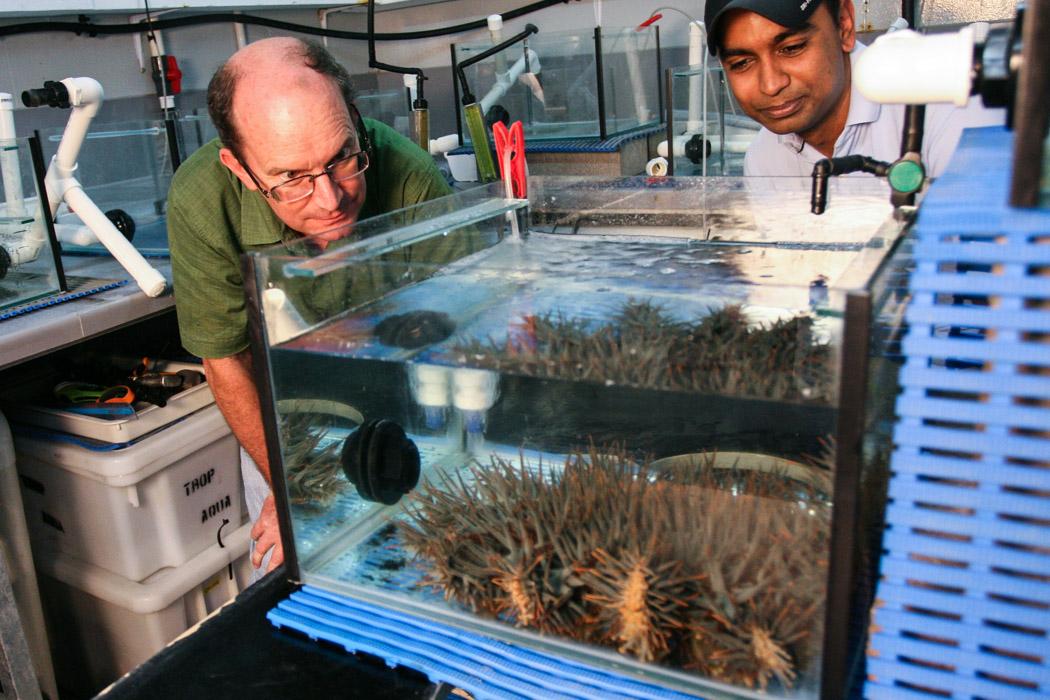FOR IMMEDIATE RELEASE I PDF (381 KB)
Scientists have decoded the genetic basis of chemical signals released by coral-eating crown-of-thorns starfish, discovering how they communicate to form aggregations and flee from predators.
The new insights, reported today in Nature, may lead to biocontrol measures that enable their mass attraction, collection and removal from coral reefs.
“This is a great example of excellence in science being achieved by pooling national and international expertise in genomics, proteomics and behavioural ecology,” senior author Dr Mike Hall of the Australian Institute of Marine Science (AIMS) says.
A crown–of-thorns starfish aggregation on the Great Barrier Reef. Scientists have cracked the genetic code of the chemical signals the crown-of-thorns starfish use to communicate. Image: AIMS
As well as researchers at AIMS, Professor Bernie Degnan of the University of Queensland was a key collaborator in the study which also involved teams led by Professor Nori Satoh at the Okinawa Institute of Science and Technology, and Associate Professor Scott Cummins at the University of the Sunshine Coast.
“Outbreaks of crown-of-thorns starfish diminish the integrity and resilience of coral reef ecosystems,” Dr Hall says.
“While local control measures have achieved some success, species-specific chemical attractants that underpin spawning aggregations have substantial potential to act as biocontrol agents on a regional scale.”
“For the first time, we are able to better understand the critical importance of the chemical communication that drives crown-of-thorns behaviour, providing excellent leads in the development of biocontrol technologies,” Professor Degnan says.
The study’s findings are based on the complete genome sequencing of two individual crown-of-thorns starfish collected more than 5000 kilometres apart: from Australia’s Great Barrier Reef and Okinawa in Japan.
“Despite this distance, both starfish secreted identical chemicals, broadening the applicability of the findings across the Indo-Pacific region, where crown-of-thorns starfish are also a coral reef pest,” Professor Satoh says.
“The chemicals, which are excreted from the external tissues including the spines, body wall and mouth, make the normally sedentary starfish become highly active,” Dr Cummins says.
“They are regulated by ‘exoproteomes’ linked to specific behavioural responses, which could be synthesised in the laboratory and used on reefs affected by crown-of-thorns outbreaks to influence starfish behaviour.
“We also found that different proteins were released by crown-of-thorns starfish that were alarmed by the presence of their main predator, the giant triton. These may provide the key to developing new dispersal control technologies.”
Senior author Dr Mike Hall (AIMS, left) and Dr Utpal Bose (USC, now CSIRO) at AIMS Townsville during investigations into the behaviour of crown-of-thorns starfish in response to chemical cues. Image: AIMS
Dr Hall says the advances in super sensitive technologies such as genome sequencing are allowing scientists to examine the importance of chemical communication within coral reefs.
“This research shows that we can finally investigate the puzzle of how coral reef ecosystems operate. The way in which all the organisms communicate either with each other, or to other species, is one of the greatest gaps in knowledge in understanding such complex systems.”
Through its strong external collaborations, AIMS research is leading the way in not only advancing knowledge of crown-of-thorns starfish control measures, but also in pioneering research into the causes and drivers of outbreaks, and management and investment strategies.
The paper ‘The crown-of-thorns starfish genome as a guide for biocontrol of this coral reef pest’ appears online today in the journal Nature.
http://dx.doi.org/10.1038/nature22033
For media enquiries:
Dr Mike Hall, AIMS Principal Research Scientist
mob: +61 (0) 407 553 408, email: m.hall@aims.gov.au
Kate Green, AIMS Communication Group
Tel: +61 (07) 4753 4265, k.green@aims.gov.au
Images and video are available for use by the media. Please contact Kate Green.



